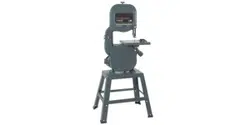Loading ...
Loading ...
Loading ...

Safety instructions for Band Saws (continued) .........
Whenever Sawbiade is Spinning:
I WARNING: Don't allow familiarity (gained from fre-
quent use of your band saw) cause a careless mis-
take, Always remember that a careless fraction of a
second is enough to cause a severe injury.
- Before starting your cut, watch the saw while it runs. If
it makes an unfamiliar noise or vibrates a lot, stop
immediately. Turn the saw off. Unplug the saw. Do not
restart untilfinding and correcting the problem.
. Before removing loose pieces from the table, turn saw
offand wait for all moving parts to stop.
Keep Children Away.
• Keep all visitors a safe distance from the table saw.
• Make sure bystanders are clear of the table saw and
workplece.
Don't Force Tool.
• Letthe blade reach full speed before cutting.
- Itwill do the job better and safer at itsdesigned rate.
- Feed the workpiece intothe saw only fast enough to let
the blade cutwithout bogging down or binding.
Before freeing jammed material.
• Turn switch "OFF".
° Unplug the saw.
oWait for all moving parts to stop.
- Remove switch key.
When backing up the workpiece, the blade may bind
in the kerr (cut). This is usually caused by sawdust
clogging up the kerr or because the blade comes out
of the guides, if this happens:
• Turn saw "OFF".
oWait for all moving parts to stop.
° Remove switch key.
° Unplug the saw.
- Remove band saw cover.
- Stick flat blade screwdriver or wedge into the kerf.
oTurn the upper whee4 by hand while backing up the
workpiece.
Before Leaving The Saw.
° Turnthe saw off.
• Wait for all moving parts to stop.
• Unplug the saw.
• Make workshop child-proof.
- Lockthe shop.
- Disconnect master switches.
- Remove the yellow switch key. Store it away from
children and others not qualified to use the tool.
Glossary Of Terms For Woodworking -
Beveling
An angle cutting operation made through the face of the
workpiece.
Compound Cutting
A simultaneous bevel and miter crosscuttingoperation.
Crosscut
A cutting operation made across the width of the work-
piece.
FPM
Feet per minute. Used in reference to surface speed of
blade.
Freehand (as used for band saw)
Performing a cut without the workpiece properly sup-
ported on the work table.
Gum
A sticky, sap based residue from wood products.
Kerr
The material removed bythe blade in a through cut or the
slot produced by the blade in a nonthrough or partial cut.
Leading End
The end of the workpiece which, is pushed into the cut-
tingtool first.
Mitering
An angle cutting operation made across the width of the
workpiece.
Push Stick
A device used to feed the workpiece through the saw dur-
ing narrow ripping type operations and helps keep the
operator's hands well away from the blade.
Resaw
A cutting operation to reduce the thickness of the work-
piece to make thinner pieces.
Resin
A sticky, sap based substance that has dried.
Ripping
A cutting operation along the length of the workpiece.
Sawblade Path
The area of the worktable or workpiece directly in line
with the saw blade.
Set
The distance the tip of the sawblade tooth is bent out-
ward from the face of the blade.
Trailing End
The workpiece end last cut bythe blade.
Workpiece
The item on which the cutting operation is being per-
formed. The surfaces of a workpiece are commonly
referred to as faces, ends, and edges.
Worktable
The surface on whichthe workpiece rests while perform-
ing a cutting or sanding operation.
4
Loading ...
Loading ...
Loading ...
